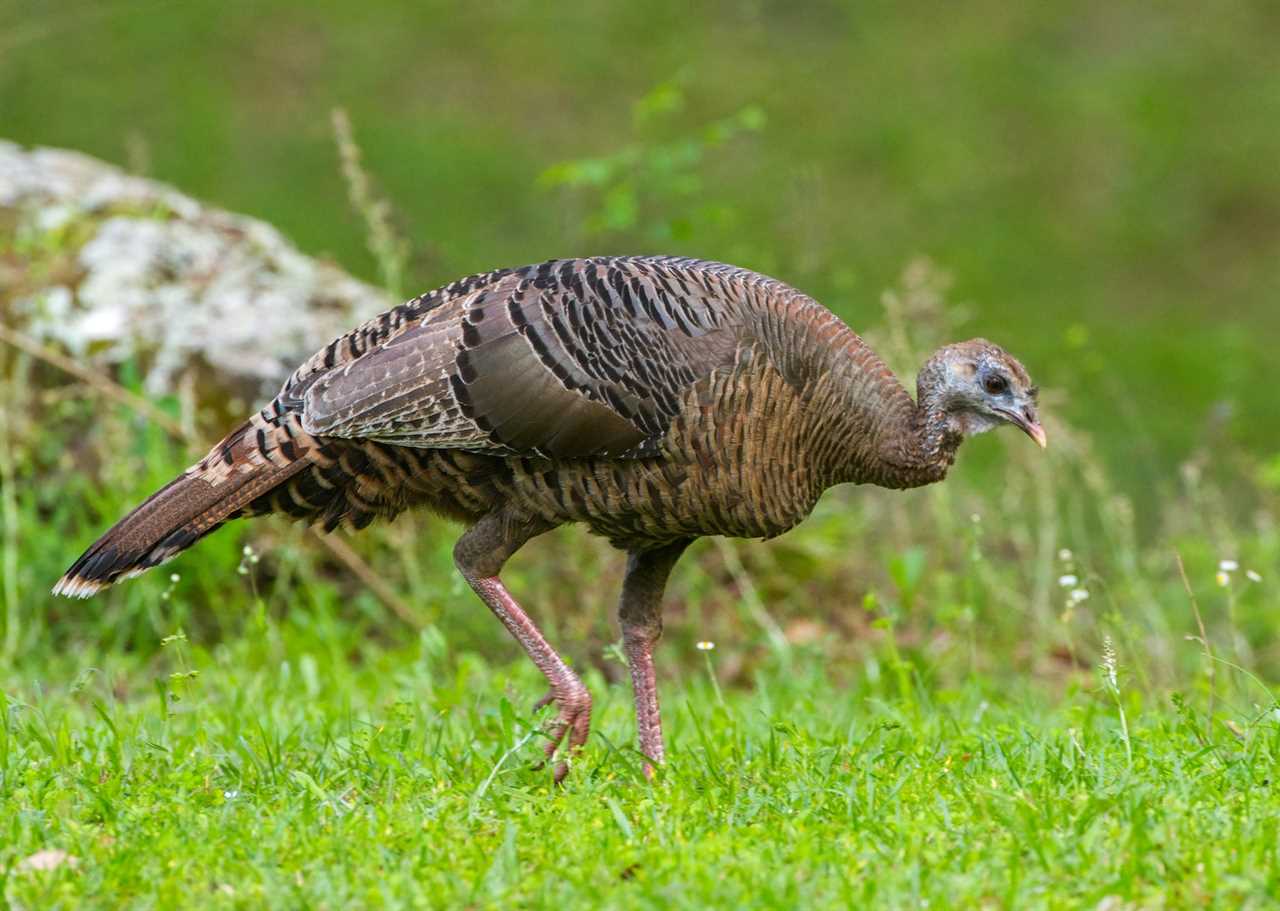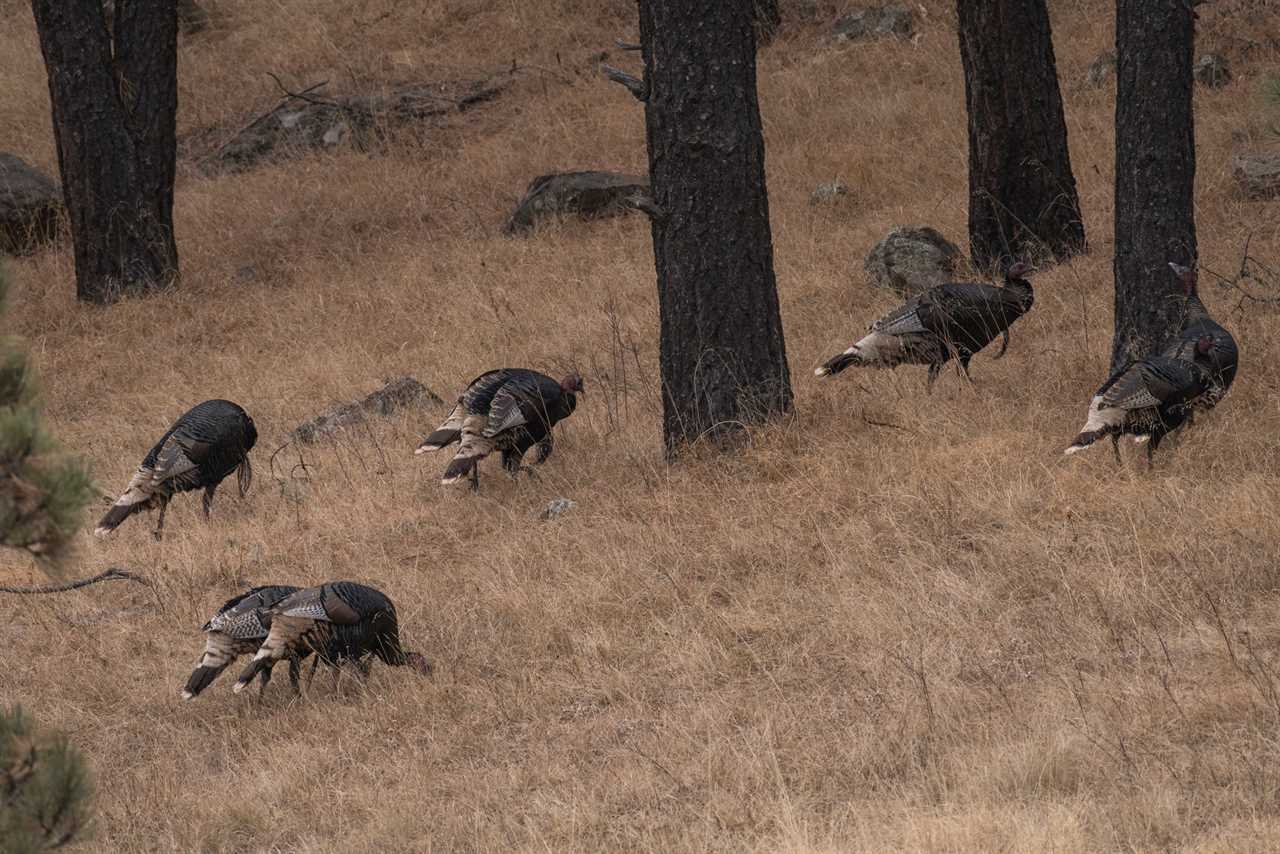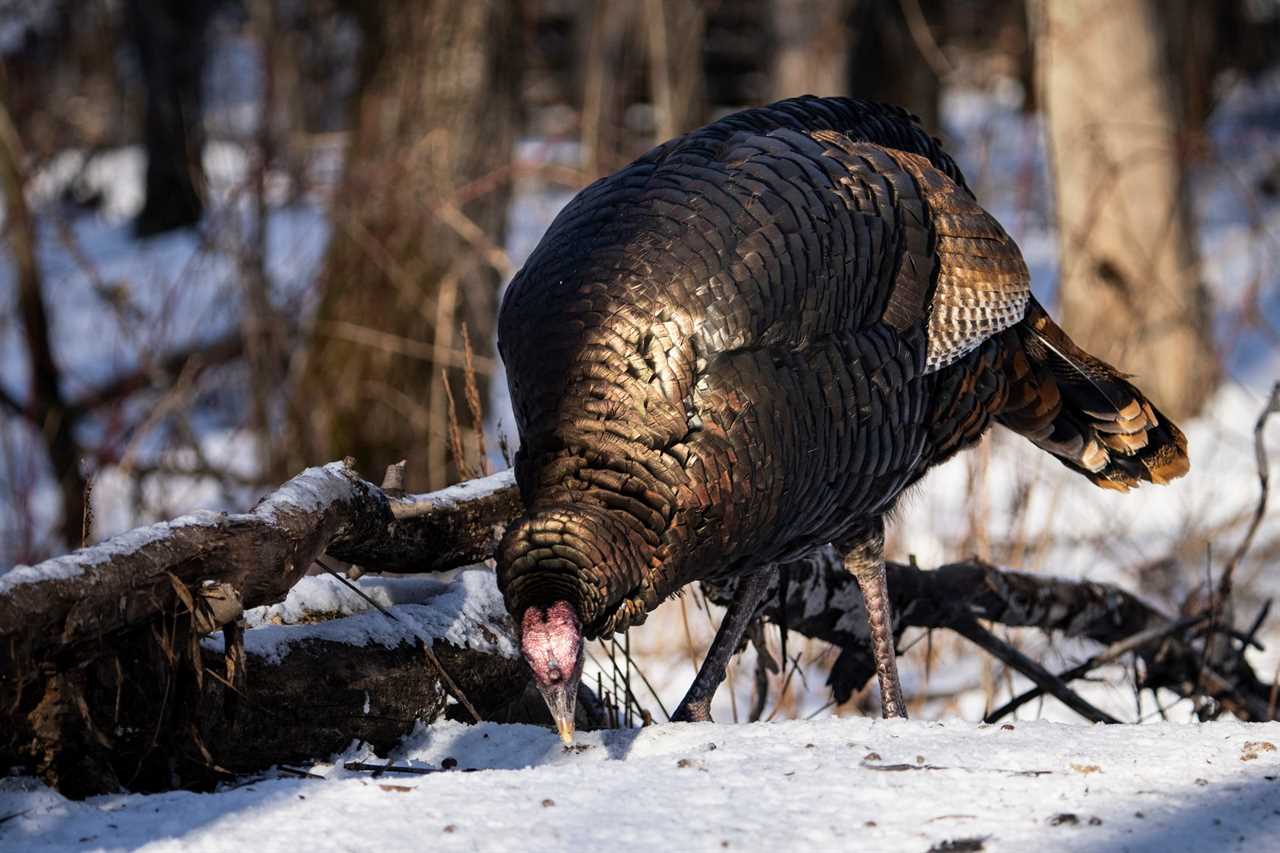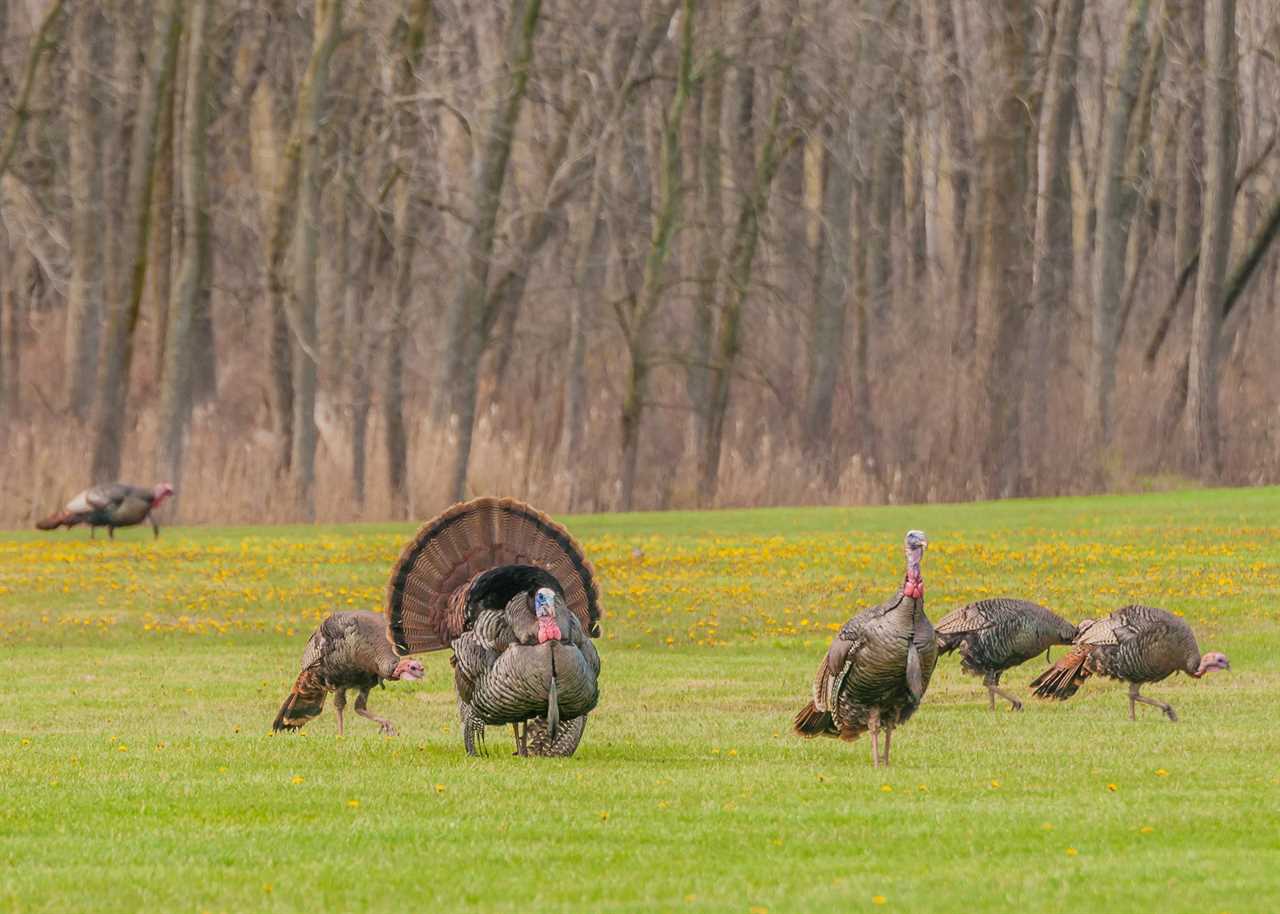A strutting gobbler looks over a hen that's feeding in an open field. John Hafner
When scouting for spring turkeys, hunters tend to concentrate their efforts on roosting areas, clearings, and travel routes between the two areas. This approach makes sense, as gobblers are more focused on strutting their stuff than securing a meal this time of year. But turkeys have to eat, too, and paying attention to food sources can pay off.
Understanding what wild turkeys eat—and why they eat certain foods at certain times of the year—is valuable knowledge for turkey hunters. From a management perspective, it can help us gauge the productivity of different habitats. And from a scouting perspective, it can help us pinpoint areas where birds are likely to congregate.
What Types of Food Do Wild Turkeys Eat?
Wild turkeys are true omnivores. This means they’ll eat just about anything they can find, including grasses, invertebrates, forbs, seeds, tubers, nuts, and fruits, along with the occasional small mammal, reptile, or amphibian. Wild turkeys living in farm country will also seek out waste grain, chaff, and other agricultural leftovers.

A hen searches for bugs during the summertime in Florida.
While plants make up the majority of a wild turkey’s annual diet, invertebrates—especially grubs and insects—are critical sources of protein for the birds. That means wild turkeys do eat pill bugs, grasshoppers, beetles, snails, caterpillars, and ticks.
Turkeys forage for these food sources throughout the day by scratching and pecking at the ground. The food is stored in the bird’s crop (an enlarged chamber in the esophagus) before it is swallowed and digested.
Inspect a Turkey’s Crop
All five subspecies of wild turkeys in North America eat this diet. The specific contents of their diet varies significantly by region, however, and the best way to understand what turkeys are eating in your area is to inspect the crop of a harvested bird.
Read Next: The Best Turkey Hunting Shotguns of 2023, Tested and Reviewed
“Sometimes you open up their crop and it’s packed full of one flower,” says Dr. Mike Chamberlain, a lifelong turkey hunter and one of the country’s leading wild turkey researchers. “Other times you’ll see ten different things.”
How the Diets of Different Turkey Subspecies Vary by Region
A wild turkey’s wide-ranging diet is part of why the birds can be found in every U.S. state outside of Alaska. And while a lot of homegrown turkey hunters picture hardwood forests in the East as quintessential turkey country, wild turkey flocks also find ways to thrive in the swamps, mountains, plains, and deserts. Here is a general breakdown of each subspecies and the major foods they tend to focus on.
Eastern Turkeys
Eastern turkeys are the largest and most abundant subspecies of wild turkey found in the U.S. They inhabit every state east of the Mississippi River, where they key in on hard mast such as acorns and beechnuts, along with seeds from native grasses and the flowers of herbaceous plants. As with the other subspecies, insects also play a valuable role in their diet.

A map showing the ranges of the different wild turkey subspecies. NWTF
Eastern turkeys in the Midwest are especially fond of waste grains and other agricultural food sources, including soy beans, corn, and wheat. A study conducted in Wisconsin looked at 100 hunter-harvested birds and found that the birds’ crops contained roughly twice as much waste grain (roughly 54 percent) as wild plants (roughly 27 percent).
Rio Grande Turkeys
Rios are native to the semi-arid southern Great Plains states, including Oklahoma, Kansas, Colorado, and Texas. They depend heavily on oaks, pecans, and other mast trees, along with insects and a variety of grasses. Researchers with Texas A&M found that a random group of Rio Grande turkeys in the state had a well-balanced diet consisting of “about 36 percent grasses, 29 percent insects, 19 percent mast, and 16 percent forbs.”
Read Next: What’s The Toughest Turkey Subspecies To Hunt?
Hydration is also extremely important to Rios and other wild turkeys in arid states. While they get most of this from surface water—creek and ponds, for example—turkeys also hydrate by eating succulent plants, which contain more water than other plants. Accordingly, prickly pears and other cacti can be important food sources for Rio Grande turkeys in deserts and scrubland habitats.
Merriam’s Turkeys
A resident of the mountains and high plains in the Western U.S., Merriam’s turkeys inhabit some hard-to-reach locales. While they prefer nuts from hardwood trees, they’ll also eat the cones and seedlings from ponderosa pines and other coniferous trees.

What do wild turkeys eat when feeding in the woods? Seeds, insects, and other forage. Debbie / Adobe Stock
Tender grass shoots and buds are other springtime favorites, and Merriam’s turkeys often feed exclusively on grasshoppers at certain times of the year, according to the Wyoming Game and Fish Department. Merriam’s turkeys living in cattle country will also concentrate on feedlots, scrounging for leftover alfalfa, barley, and other waste grains.
In a study conducted on Merriam’s turkeys in South Dakota’s Black Hills, the U.S. Fish and WIldlife Service found that “adult birds consumed 78 different kinds of food” throughout the year. But four main food groups dominated their crops: ponderosa pine seeds, bearberries (also known as manzanita), green grasses, and arthropods (mainly grasshoppers and beetles).
Osceola Turkeys
Found exclusively in Florida, these colorful turkeys are at home in the swamps and the open pastures in the interior of the state. Birds in the swamp tend to incorporate more frogs, salamanders, and other small amphibians into their diet, while dryland birds focus more on grubs and acorns. Favorite foods also include berries, wild grapes, ferns, and other plants.
Gould’s Turkeys
The rarest of the five wild turkey subspecies, Gould’s turkeys can only be found in the mountains of Arizona and New Mexico. (Their range also stretches south into Mexico.) Their diet is similar to Rio Grande turkeys and includes various species of grasses and cactus, with the occasional lizard thrown in. They also key in on piñon nuts and berries from the scraggly juniper trees that are common throughout the Southwest.
Turkey Food Varies by Season
Aside from the regional availability of certain foods, the time of year also dictates what wild turkeys eat. This is because some foods are more plentiful at certain times of the year—but also because turkeys change their habits along with the seasons. Over the course of his 30-plus years studying America’s largest game bird, Chamberlain has watched these dietary shifts occur year in and year out like clockwork.
“If you look at turkeys across the year, their fall and winter is tied to food,” Chamberlain says. “That’s all they’re worried about, surviving and eating.”

A wild turkey feeds in a hardwood forest during the winter. Adobe stock
Hard mast provides a high-energy, high-protein food source to get the birds through the colder months. And when acorns are plentiful in the fall and winter months, you can often find turkeys in and around hardwoods. Timber stands within striking distance of a farmer’s field or a rancher’s feedlot are even better places to look.
“As soon as turkeys come out of winter, they use completely different habitats. I call it the spring shift,” Chamberlain says. “The reason for that is they tend to go back to the same places every year to breed.”
Turkey habitat in the spring revolves around clearings and open areas, Chamberlain explains. Turkeys need to be able to see one another, and the gobblers need plenty of room to strut. But these open, grassy areas provide plenty of turkey food, too. The birds typically key in on the fresh shoots, grasses, and other green forage cropping up in fields during the springtime. Insects also start to play a larger role in their diet as the weather warms.
Read Next: Why Do Turkeys Gobble at Owls?
As the breeding season wraps up, hens shift their focus to nesting. Female turkeys need a safe place to hide and sit on their eggs for a month. Shrubbier, grassier areas with dense cover usually fit the bill.
Then comes the summer, which is a plentiful time for hungry turkeys. A wide variety of edible plants are available, from blackberries to fresh buds and flower bulbs. Insect populations also peak during this season and play an even more important role in a turkey’s diet. Poults in particular need a steady diet of bugs for healthy growth during their first few months of life. The Michigan Department of Natural Resources points out that a typical poult’s diet will consist of 75 percent insects or more during their first summer. Adult turkeys also molt in the summertime, and insects give them the protein they need to grow new feathers.
“Then,” says Chamberlain, “they rinse and repeat that cycle every year.”
Turkey Hunters Should Focus on Food in the Spring
Spring turkey hunters who also chase deer during the rut can look at food sources for turkeys in much the same way. While male birds might be more interested in mating than eating, the females are eating like crazy in preparation for nesting season. (Just imagine how much you’d be eating if you were getting ready to sit in one spot and fast for a month.) Finding wild turkey food sources can help you find the hens. And once you find hens, you’ll find the toms.

Turkeys like to eat fresh green vegetation and showy wildflowers in the springtime. Adobe stock
“If you think about it from a hen’s perspective, she’s stocking up on resources, taking care of herself, increasing fat stores, and getting ready to produce eggs,” Chamberlain explains. “And toms are going to areas where they can interact with hens. So, by default, they’re going to end up in areas with high quality forage.”
Chamberlain says that in all his years chasing gobblers, he’s noticed that they can only strut for so long before they have to stop and eat. This often happens during the afternoon, when most birds will have worked up an appetite.
“They’ll seem oblivious to food for hours and hours,” he says, “and all the sudden you’ll get a tom who takes a break and gorges himself on something available.”
Read Next: Turkey Vision: Here’s What Hunters Should Know About How Wild Turkeys See
As for specific food sources that hunters can target in the spring, Chamberlain points to fresh green vegetation and flowers. These food sources attract insects, which gives the turkeys a two-for-one special they can’t resist.
“Pay attention to anything that’s attracting insects. The [bugs] are going to track succulent forage, and then as the vegetation becomes more rank, they’ll move on,” he says. “Turkeys aren’t only eating the insects, though. They’re eating the seeds and green forage as well.
“Another link I’ve noticed personally is between insects and showy, attractive flowers. The birds show up and they can eat the flowers, but they can also work on the insects that are attracted to the flowers.”
Food Plots for Turkeys
While hunters tend to associate food plots with deer more than anything, they can play a valuable role in supplementing a wild turkey’s diet—especially when pickings are slim during the fall and winter months. Also, in the same way they attract whitetails, food plots can help draw turkeys in regularly and establish predictable movement patterns.
As an added bonus, turkeys and deer like to eat a lot of the same things, including oats, clover, soybeans, and corn. This means that the food plot you planted for whitetails should bring in plenty of Eastern turkeys, too.

Turkeys are drawn to ag fields like this one in Wisconsin, and will use smaller turkey-specific food plots, too. mtatman / Adobe Stock
Native wildflowers are good additions for turkey-specific food plots. So are bunch grasses, which provide good cover for the birds. Chufa is another popular crop planted specifically for wild turkeys. Also marketed as Turkey Gold by the National Wild Turkey Federation, chufa is an exotic variety of the native nutsedge. It produces a small tuber that grows underground and is similar to a peanut. Chufa generally grows anywhere that corn will. It does better in warmer climates, however, and is most popular in the South.
Read Next: The Best Turkey Vests of 2023, Tested and Reviewed
When considering locations for turkey-specific food plots, focus on the edges of hardwood forests, where the birds can retreat to cover and find good roosting trees. Close proximity to water is another important consideration.
But even if you don’t have the time or the property to plant a food plot for turkeys, there’s plenty of food that a wild turkey will eat. In fact, it might seem daunting to pinpoint one particular food source during turkey season. But the more you watch wild turkeys, the more you’ll start to understand their eating habits. After a few seasons of this, you’ll have a much better idea of what wild turkeys eat in your neck of the woods. And you’ll be prepared to interrupt their breakfast.
The post What Do Wild Turkeys Eat? appeared first on Outdoor Life.
Articles may contain affiliate links which enable us to share in the revenue of any purchases made.
By: Dac Collins
Title: What Do Wild Turkeys Eat?
Sourced From: www.outdoorlife.com/hunting/what-do-wild-turkeys-eat/
Published Date: Wed, 29 Mar 2023 22:59:41 +0000
----------------------------------------------
 Backyard GrillingWeekend WarriorsAdvice from DadBeard GroomingTV Shows for Guys4x4 Off-Road CarsMens FashionSports NewsAncient Archeology World NewsPrivacy PolicyTerms And Conditions
Backyard GrillingWeekend WarriorsAdvice from DadBeard GroomingTV Shows for Guys4x4 Off-Road CarsMens FashionSports NewsAncient Archeology World NewsPrivacy PolicyTerms And Conditions
